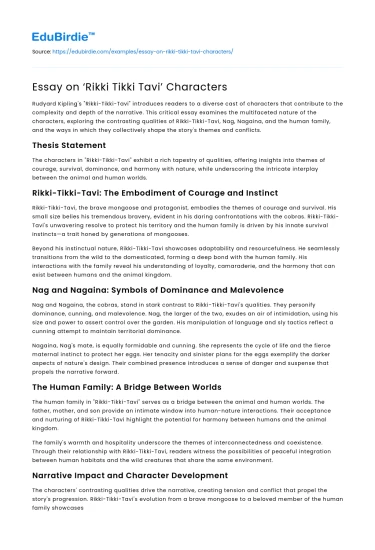Rudyard Kipling's "Rikki-Tikki-Tavi" introduces readers to a diverse cast of characters that contribute to the complexity and depth of the narrative. This critical essay examines the multifaceted nature of the characters, exploring the contrasting qualities of Rikki-Tikki-Tavi, Nag, Nagaina, and the human family, and the ways in which they collectively shape the story's themes and conflicts.
Thesis Statement
The characters in "Rikki-Tikki-Tavi" exhibit a rich tapestry of qualities, offering insights into themes of courage, survival, dominance, and harmony with nature, while underscoring the intricate interplay between the animal and human worlds.
Save your time!
We can take care of your essay
- Proper editing and formatting
- Free revision, title page, and bibliography
- Flexible prices and money-back guarantee
Rikki-Tikki-Tavi: The Embodiment of Courage and Instinct
Rikki-Tikki-Tavi, the brave mongoose and protagonist, embodies the themes of courage and survival. His small size belies his tremendous bravery, evident in his daring confrontations with the cobras. Rikki-Tikki-Tavi's unwavering resolve to protect his territory and the human family is driven by his innate survival instincts—a trait honed by generations of mongooses.
Beyond his instinctual nature, Rikki-Tikki-Tavi showcases adaptability and resourcefulness. He seamlessly transitions from the wild to the domesticated, forming a deep bond with the human family. His interactions with the family reveal his understanding of loyalty, camaraderie, and the harmony that can exist between humans and the animal kingdom.
Nag and Nagaina: Symbols of Dominance and Malevolence
Nag and Nagaina, the cobras, stand in stark contrast to Rikki-Tikki-Tavi's qualities. They personify dominance, cunning, and malevolence. Nag, the larger of the two, exudes an air of intimidation, using his size and power to assert control over the garden. His manipulation of language and sly tactics reflect a cunning attempt to maintain territorial dominance.
Nagaina, Nag's mate, is equally formidable and cunning. She represents the cycle of life and the fierce maternal instinct to protect her eggs. Her tenacity and sinister plans for the eggs exemplify the darker aspects of nature's design. Their combined presence introduces a sense of danger and suspense that propels the narrative forward.
The Human Family: A Bridge Between Worlds
The human family in "Rikki-Tikki-Tavi" serves as a bridge between the animal and human worlds. The father, mother, and son provide an intimate window into human-nature interactions. Their acceptance and nurturing of Rikki-Tikki-Tavi highlight the potential for harmony between humans and the animal kingdom.
The family's warmth and hospitality underscore the themes of interconnectedness and coexistence. Through their relationship with Rikki-Tikki-Tavi, readers witness the possibilities of peaceful integration between human habitats and the wild creatures that share the same environment.
Narrative Impact and Character Development
The characters' contrasting qualities drive the narrative, creating tension and conflict that propel the story's progression. Rikki-Tikki-Tavi's evolution from a brave mongoose to a beloved member of the human family showcases character growth and adaptation. His courage and resourcefulness in confronting the cobras emphasize his transformation from a mere protector to a symbol of unity between species.
Similarly, Nag and Nagaina's malevolence deepens the conflict, setting the stage for Rikki-Tikki-Tavi's ultimate triumph. Their roles as antagonists amplify the mongoose's heroism, elevating the stakes and intensifying the emotional impact of the narrative's climax.
Convergence of Themes
The characters' interactions and qualities converge to reinforce the story's overarching themes. Rikki-Tikki-Tavi's courage in confronting Nag and Nagaina exemplifies the triumph of good over evil, while Nag and Nagaina's dominance and malevolence underscore the tension between instinctual survival and territorial aggression. The human family's acceptance and care for Rikki-Tikki-Tavi mirror the theme of harmony between humans and the natural world.
These themes intertwine to create a layered narrative that challenges readers to consider the complexities of the animal kingdom, the human-animal relationship, and the intricacies of character motivations.
Conclusion
In "Rikki-Tikki-Tavi," Rudyard Kipling masterfully crafts characters that span the spectrum of qualities—courage, dominance, malevolence, and harmony. Each character's uniqueness contributes to the narrative's depth, underscoring the interplay between instinct, survival, and the potential for coexistence between humans and the animal kingdom. As readers navigate the intricate web of character dynamics, they are invited to contemplate the richness of the natural world and the intricate tapestry of life that weaves us all together.






 Stuck on your essay?
Stuck on your essay?

